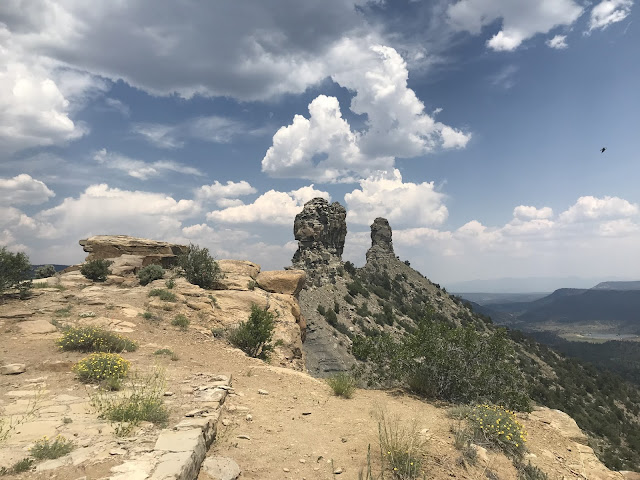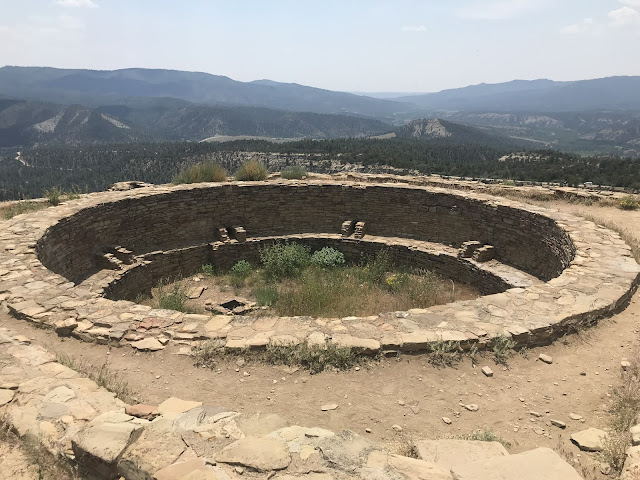
Pagosa Springs, Colorado
While visiting our close friend who lives in Pagosa Springs, we took a day to visit Chimney Rock National Monument located in the San Juan National Forest. Visits and tours at the Monument are coordinated by the Chimney Rock Interpretive Association for the National Forest Service. Whether you choose to do a self-guided tour or one of the focused tours, you will schedule it through the CRIA. We choose a self-guided tour and used their very convienent audio tour through a smartphone app. Be sure to down load the app before your visit as cell reception at the Monument is spotty.
Self-guided tours follow two separate trails accessing two key locations of the site. The Mesa Village Trail is a paved half mile trail giving you a view of the Piedra River Valley and Peterson Ridge as well as passing excavated and restored Pithouse and the Great Kiva.
The Great House Pueblo Trail travels almost a half mile along the exposed mesa ridge to the Great House Pueblo and a stunning view of Chimney and Companion Rocks. It is up here that you begin to understand the significance of the site not just from architecture and archeological perspectives but also from an astrological perspective.
The entire site appears to be centered on the Northern Major Lunar Standstill, a natural astrological event that occurs every 18.6 years. It is during this event that the moon rise is seen between the two pinnacles as viewed from the Great House. While the Ancient Puebloans left no written histories it is believed that those shamans who interpreted the astrological signs lived and ruled from the Great House.
 |
Piedra River Valley and the Peterson Ridge. Archeologists believe that the houses at Chimney Rock were where inhabitants lived, while using the valley to grow crops and hunt for food.
|
 |
The reconstructed Pithouse at Mesa Villiage. This area was considered to be a part of the Chacoan regional community whose hub was Chaco Canyon located 100 miles southwest in New Mexico. Chimney Rock was only one part of this network. This pithouse was excavated by archeologists, and then reconstructed as an example of how the Ancient Puebloans lived. There remain a number of unexcavated sites on the mesa preserving the history that lies below.
 |
Located along the side of the pithouse were storage and work rooms. Located in one were several matates where grain would be ground for food.
 |
| This Mano (small rock for grinding) and Matate (stone base) were found at Chimney Rock. Notice how long it must have been in use shown by the trough worn down the center of the Matate. They believe that People lived in the region for at least 14,000 years. The Ancient Puebloans lived here from AD925 to AD1125. No one knows for certain where they went from here. |
 |
The Great Kiva at Mesa Village. Reconstructed to show the central fire ring and the square foot drums on either side.
Wildflowers of Chimney Rock
 |
 |
| The Great House Pueblo Trail rises from the parking lot and follows the ridge line to the structure and a stunning view of the Chimney Rock Pinnacles. Along the way it passes many pithouses located along the ridge top. |
 |
The Ridge House is only one of about 200 structures found within the monument. It follows the design of other pithouses except that a larger portion would be visible above ground because these were built on bedrock. A traditional pithouse would be mostly underground. Missing from this reconstruction would be the adobe roof and walls as well as the logs that supported them.

Looking onto the floor of the pithouse you see where the cooking and warming fire would be located in the center. You can also see the opening at the base of the wall where the fire would draw in outside air. The stones between were used to deflect the incoming air so as not to disturb the fire. Smoke escaped the pithouse through an access hole in the roof, which was also used as the main entry into the home.
|


 |
| Walking along the ridge top, and looking into the valley you can begin to understand how this spot was associated with the broader Chacoan community. Archeologists have found evidence of large fires here. Looking southwest from here you can see the distant Huerfano Mesa. A signal fire here could easily be seen on that mesa. From Huerfano signal fires could bee seen at Far View house at Mesa Verde, Pueblo Alto in Chaco Canyon and the Great House at Chimney Rock. An enterprising high school student proved the point by using signaling mirrors demonstrating the available lines of sight. |
 |
| Approaching the Great House Pueblo you first see these straight masonry walls with squared corners. It is a feature that identifies the area as connected to the greater Chacoan community. Pithouses of this era and in other places in this region were round. At Chimney Rock we find a combination of round and square structures more common in Chaco canyon. These structures were probably built by the Chacoans. |
 While the Great House Pueblo is a reconstructed excavation, there is an effort to show how the walls would have been constructed. Here is an example of a reconstructed wall. Looking closely you can see where cement was used to solidify the wall and connect the stones.
While the Great House Pueblo is a reconstructed excavation, there is an effort to show how the walls would have been constructed. Here is an example of a reconstructed wall. Looking closely you can see where cement was used to solidify the wall and connect the stones.
 In this photo you can see how the walls were originally built. The stones are stacked and lack the cement to stabilize the wall. The combination of circular pithouses and rectangular mason are rooms seen throughout the structures indicate Chacoan Architecture.
In this photo you can see how the walls were originally built. The stones are stacked and lack the cement to stabilize the wall. The combination of circular pithouses and rectangular mason are rooms seen throughout the structures indicate Chacoan Architecture.
 |
Arriving at the Great House Pueblo, in addition to the structure itself you get this wonderful view of the pinnacles and begin to understand the interrelationship with the Great House Pueblo.
 |
From the Great House, looking east, you see that it aligns perfectly to see the moonrise between the pinnacles. Interestingly this only happens every 18.6 years during the Northern Major Lunar Standstill, which occurs at the full moon nearest the Winter Solstice. Were these structures purpose built for the event or merely happenstance. The CRAI conducts full moon tours at the site, but in order to see the Standstill, you will have to visit sometime between 2022 and 2025. The Standstill lasts for about 3 years, and the best time to see it at Chimney Rock would be in 2023.
 |
| The Kiva’s looking west |
 |
| Why did these people live on these ridge tops instead of the lush valleys below? Why did they disappear in 1125? Where did they go? Why is there no record of them other that the remains of these pithouses and the middens left behind? These are interesting and compelling questions as you visit Chimney Rock National Monument. |



 While the Great House Pueblo is a reconstructed excavation, there is an effort to show how the walls would have been constructed. Here is an example of a reconstructed wall. Looking closely you can see where cement was used to solidify the wall and connect the stones.
While the Great House Pueblo is a reconstructed excavation, there is an effort to show how the walls would have been constructed. Here is an example of a reconstructed wall. Looking closely you can see where cement was used to solidify the wall and connect the stones. In this photo you can see how the walls were originally built. The stones are stacked and lack the cement to stabilize the wall. The combination of circular pithouses and rectangular mason are rooms seen throughout the structures indicate Chacoan Architecture.
In this photo you can see how the walls were originally built. The stones are stacked and lack the cement to stabilize the wall. The combination of circular pithouses and rectangular mason are rooms seen throughout the structures indicate Chacoan Architecture.



























Comments
Post a Comment